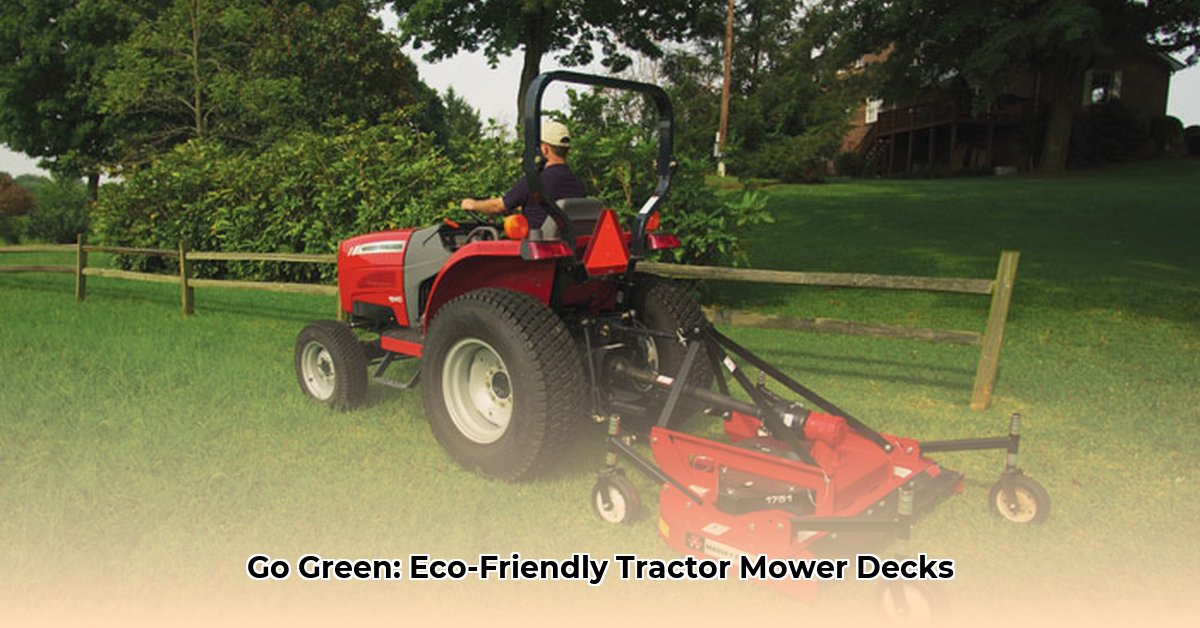
Choosing the right mower deck significantly impacts your lawn's health and environmental footprint. This guide compares mulching and traditional mowing, helping you select the ideal John Deere mower for your needs. Whether you're a seasoned landscaper or a homeowner, learn how to optimize your mowing practices for a sustainable and thriving lawn. For more options, check out our tractor mowers.
Understanding Mulching vs. Traditional Mowing
Traditional mowing involves cutting grass and collecting or discharging clippings. Mulching, conversely, finely shreds grass, returning it to the lawn as natural fertilizer. This seemingly simple difference profoundly impacts lawn health and your environmental impact. Isn't it fascinating how such a small change can have such a significant, positive effect?
Traditional mowing often leads to nutrient loss, requiring additional fertilizer. However, mulching recycles nutrients, often eliminating the need for chemical fertilizers entirely. This reduces costs and minimizes the environmental impact of chemical runoff.
Mulching Mowers: A Natural Approach
Mulching mower decks finely shred grass, scattering nutrient-rich particles across your yard. This acts as a natural fertilizer, promoting a healthier, greener lawn. This method offers a number of advantages:
- Cost Savings: Reduced or eliminated fertilizer costs.
- Improved Soil Health: Enhanced soil fertility and water retention.
- Environmental Friendliness: Minimized chemical use and waste.
However, mulching also presents some potential drawbacks:
- Clumping: Potential for clumping if grass is too tall or wet.
- Aesthetic Preferences: Some prefer the perfectly manicured look of traditional mowing.
- Frequency: More frequent mowing may be required.
Traditional Mowing: The Established Method
Traditional mowing systems either bag clippings or discharge them to the side. This provides a neat, tidy lawn. While familiar and effective, it has some downsides:
- Waste Disposal: Handling grass clippings can be inconvenient and wasteful.
- Nutrient Loss: Valuable nutrients are lost instead of returning to the soil.
- Higher Environmental Impact: Increased reliance on chemical fertilizers and more waste.
Choosing the Right System
The optimal mowing system depends on various factors:
- Lawn Size: Mulching is often more efficient for larger lawns.
- Grass Type: Certain grasses mulch better than others.
- Climate: Wet climates can hinder effective mulching.
- Aesthetics: Consider your preference for a manicured or natural look.
- Budget: While mulching may save money long-term, the initial investment can be higher.
Mastering Mulching Techniques
Effective mulching requires proper technique. Follow these steps:
- Sharp Blades: Dull blades tear grass, leading to poor mulching and clumping. Ensure your blades are sharp before each mowing session.
- The "One-Third Rule": Never remove more than one-third of the grass blade's height in a single mowing.
- Mowing Height: Experiment to find the ideal height for your lawn type and mower.
- Deck Maintenance: Regularly clean your mower deck to prevent clogging and ensure optimal performance.
- Weather: Avoid mulching wet grass, as this can lead to clumping.
Traditional Mowing Best Practices
For traditional mowing, these steps ensure a neat and efficient process:
- Correct Height Adjustment: Set your mower to the recommended height for your grass type.
- Proper Clipping Disposal: Compost clippings or dispose of them responsibly to avoid environmental problems.
Long-Term Benefits and Cost Savings
Mulching offers significant long-term benefits:
- Reduced Fertilizer Costs: Significantly cuts down on or even eliminates the need for fertilizer.
- Improved Soil Health: Creates a healthier, more fertile soil, leading to a more resilient lawn.
- Water Conservation: Improved soil structure promotes better water retention, potentially reducing watering needs.
These benefits translate to long-term cost savings and a more environmentally friendly lawn care practice.
Conclusion: Sustainable Lawn Care with John Deere
The choice between mulching and traditional mowing hinges on individual needs and preferences. Careful consideration of your lawn's characteristics, budget, and sustainability goals will guide you toward the best option. With the right mower and techniques, you can achieve a healthy, beautiful lawn while reducing your environmental impact.